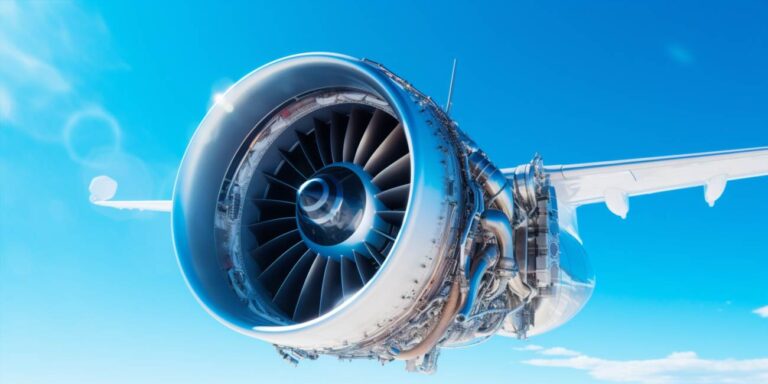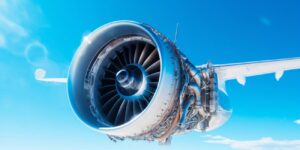The basic principles of operation of a jet engine involve the intake of air, compression of the air, combustion of fuel, and the expulsion of high-speed exhaust gases. These processes occur within the engine’s core components, namely the compressor, combustion chamber, and turbine.
The compressor plays a pivotal role in the jet engine’s operation. It takes in large volumes of air and compresses it before directing it to the combustion chamber. This compression is crucial as it increases the air pressure and temperature, optimizing conditions for combustion.
Within the combustion chamber, the compressed air mixes with fuel, initiating combustion. This combustion process results in a significant release of energy in the form of high-pressure, high-velocity exhaust gases. The rapid expansion of these gases forces them through the turbine.
The turbine is another critical component. As the high-velocity gases pass through the turbine, they cause it to spin. This rotational energy is then used to drive the compressor and other accessories, creating a self-sustaining cycle within the engine.
The expelled gases, now at high velocity, exit the engine through a nozzle. This expulsion of high-speed gases in one direction adheres to Newton’s third law, resulting in an equal and opposite reaction that propels the aircraft forward.
Jet engines come in various types, such as turbojet, turbofan, and turboprop, each with its own set of advantages and applications. The most common among them in contemporary aviation is the turbofan engine, known for its efficiency and quiet operation.
A turbofan engine combines elements of both jet propulsion and bypass airflow. In addition to the primary jet thrust generated by the core engine, a significant portion of the incoming air bypasses the core, contributing to additional thrust and enhancing fuel efficiency. This design is favored for commercial airliners, where fuel efficiency and noise reduction are paramount.
Turbojet engines with their simpler construction but limited capabilities
Turbojet engines, characterized by their simpler construction but limited capabilities, have played a significant role in the evolution of aviation technology. These engines operate on the basic principles of air compression, combustion, and thrust generation.
The simplicity of turbojet engines lies in their straightforward design, consisting of essential components such as a compressor, combustion chamber, and turbine. This uncomplicated construction facilitates ease of maintenance and repair, making them more cost-effective in certain applications.
The heart of a turbojet engine is its compressor, responsible for drawing in and compressing air before it enters the combustion chamber. The compressed air then mixes with fuel, undergoes combustion, and produces a high-speed exhaust that propels the aircraft forward.
While their simplicity is advantageous, turbojet engines exhibit limitations that have led to their phased-out use in modern commercial aviation. One of the primary drawbacks is their inefficiency at low speeds and altitudes, making them less fuel-efficient during takeoff and climb phases.
Furthermore, turbojet engines face challenges in terms of thrust control and maneuverability compared to more advanced propulsion systems. This limitation makes them less suitable for applications requiring rapid changes in speed or direction, such as in modern fighter jets.
The table below provides a concise overview of the key characteristics of turbojet engines:
| Aspect | Description |
|---|---|
| Construction | Simpler design with basic components. |
| Efficiency | Less efficient at low speeds and altitudes. |
| Maintenance | Easy to maintain and repair, cost-effective. |
| Thrust Control | Challenges in precise thrust control. |
| Maneuverability | Less maneuverable compared to advanced engines. |
While turbojet engines have paved the way for aviation advancements, their limitations have led to the development and adoption of more sophisticated propulsion technologies, such as turbofans and high-bypass engines. These advancements aim to address the shortcomings of turbojets, providing improved fuel efficiency, thrust control, and overall aircraft performance.
Key advantages and disadvantages of ramjets and their niche applications
The ramjet and scramjet technologies represent cutting-edge advancements in the realm of propulsion systems, offering distinct advantages and drawbacks that cater to specific niche applications. Understanding the intricacies of these technologies requires delving into their key characteristics.
Ramjets, characterized by their simplicity and reliability, find their niche primarily in applications requiring sustained high-speed flight. Their operational principle involves compression of incoming air through the engine’s inlet, relying on the vehicle’s initial velocity to achieve compression. This results in a more straightforward design, making ramjets suitable for missiles and high-speed aircraft where simplicity and efficiency are paramount.
However, the inherent limitation of ramjets lies in their dependence on initial velocity. This means they are ineffective at low speeds and need alternative propulsion systems for takeoff. The absence of moving parts, while enhancing reliability, also restricts their adaptability to variable speed conditions.
Scramjets, on the other hand, come into play at higher speeds, particularly in the realm of hypersonic flight. The acronym itself – supersonic combustion ramjet – highlights their operational domain. Scramjets boast unparalleled efficiency in the mach speed range, excelling where traditional jet engines falter.
Unlike their ramjet counterparts, scramjets can operate efficiently at hypersonic speeds without the need for pre-compressed air. This unique capability makes them the preferred choice for applications demanding sustained high velocities, such as advanced spaceplanes and hypersonic missiles.
When comparing power efficiency, scramjets often outperform ramjets at hypersonic speeds due to their ability to compress incoming air effectively. However, this efficiency comes at the cost of complexity, as scramjets require intricate engineering to manage supersonic combustion and airflow at extremely high speeds.
In the context of rocket engine technology, both ramjets and scramjets serve as essential components in achieving optimal performance. Ramjet-powered stages handle lower-speed portions of the flight, seamlessly transitioning to scramjet propulsion as the vehicle accelerates into the hypersonic regime.
Table: Comparing Ramjets and Scramjets
| Aspect | Ramjets | Scramjets |
|---|---|---|
| Operational Range | High-speed flight | Hypersonic flight |
| Power Efficiency | Efficient at high speeds | Optimal at hypersonic speeds |
| Complexity | Simple design | Requires intricate engineering |
Evolution towards more complex turbofan and open rotor architectures for improved efficiency
In the ever-evolving realm of aviation propulsion, the quest for efficiency has led to a fascinating journey of technological advancements. The evolution towards more complex turbofan and open rotor architectures stands as a testament to the industry’s commitment to achieving optimal performance.
The open rotor concept, characterized by unshrouded, contra-rotating blades, has gained traction for its potential in overcoming the limitations of traditional turbofans. This innovative approach capitalizes on increased bypass ratios and improved propulsive efficiency, directly addressing concerns related to fuel consumption and emission reductions.
One remarkable manifestation of this evolutionary path is the open rotor geared turbofan (ORGT) engine, a hybrid marvel that amalgamates the best features of both open rotors and geared turbofans. The geared aspect allows for optimized blade speed, unlocking unprecedented levels of efficiency and performance.
The utilization of geared systems in the context of turbofan engines has proven to be a game-changer. It enables the decoupling of the low-pressure turbine from the fan, facilitating independent control of each component. This newfound flexibility allows for finer adjustments, tailoring the engine’s operation to specific flight conditions and optimizing performance across a broader spectrum.
When it comes to fuel consumption, the open rotor geared turbofan excels by enhancing the propulsive efficiency through its unique blade configuration. The contra-rotating blades, unshrouded and open to the airflow, minimize drag and increase bypass ratios, translating to significant improvements in fuel efficiency.
The reduction in fuel consumption is not merely an economic benefit but a crucial step towards environmental sustainability. As the aviation industry faces mounting pressure to curb emissions, the open rotor geared turbofan blade engine emerges as a pivotal player in achieving these targets.
By optimizing the combustion process and harnessing the advantages of geared propulsion, these engines contribute to a substantial reduction in harmful emissions. The open rotor architecture, with its efficient bypass flow and advanced blade design, plays a vital role in achieving a greener aviation landscape.
As we navigate the skies of the future, the trajectory of aviation propulsion is unmistakably directed towards intricate solutions that harmonize efficiency, performance, and environmental consciousness. The open rotor geared turbofan blade engine represents a milestone in this evolutionary journey, promising a paradigm shift in how we propel our aircraft towards a more sustainable and efficient future.






